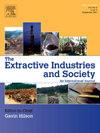在豪滕省建立尾矿库数据库
IF 4.3
2区 社会学
Q2 ENVIRONMENTAL STUDIES
Extractive Industries and Society-An International Journal
Pub Date : 2024-10-05
DOI:10.1016/j.exis.2024.101547
引用次数: 0
摘要
作为实现零伤害的第一步,有必要了解尾矿库 (TSF) 的规模和严重程度,以便进行风险评估。南非各省没有公开的 TSF 数据库,无法详细了解 TSF 的风险分布和特征。与 TSF 相关的案例,如 Jagersfontein 尾矿坝溃坝和北金沙垃圾场非法采矿者的犯罪挑战,都是建立可公开访问的 TSF 数据库的重要动机,尤其是在豪登省。这项研究的目标是建立一个包含尾矿坝空间分布的尾矿坝数据库,并根据其运营活动状况对每个尾矿坝进行分类。矿产资源和能源部公布了 TSF 数据,并将其用于创建数据库。由于坐标数据的限制,ArcGIS Pro 只能显示 94 个 TSF。研究发现,豪登省的活跃和不活跃 TSF 几乎各占一半。大多数活跃的 TSF 位于豪登省的东兰德。此外,在豪滕省拥有部分 TSF 的公司包括德班 Roodepoort Deep Gold,该公司拥有 70% 的 TSF,其次是 AfriSam(6%)和 Blyvoor Gold(4%)。公司需要披露其所有 TSF 数据,以加强数据库。本文章由计算机程序翻译,如有差异,请以英文原文为准。
Establishing a tailings storage facility database in Gauteng
As an initial step of zero harm, an understanding of the scale and magnitude of Tailings Storage Facilities (TSFs) is necessary for risk assessments. There is no publicly available TSF database in each South African province with details on TSF distribution of risks and characteristics. TSF-related cases such as the Jagersfontein Tailings Dam failure and the crime challenges by illegal miners at the North Sands Dump are significant motivations to establish a publicly accessible TSF database, especially in Gauteng. The objectives of the study were to establish a TSF database comprising the spatial distribution of TSFs and to classify each TSF by its operational activity status. The Department of Mineral Resources and Energy publishes data on TSFs, and it was used to create the database. Due to coordinate data limitations, only 94 TSFs could be presented on ArcGIS Pro. The study finds that there is almost an equal split of active and inactive TSFs in Gauteng. Most active TSFs are situated in the East Rand of Gauteng. Furthermore, companies that own some of the TSFs in Gauteng include Durban Roodepoort Deep Gold, which owns 70 % of TSFs, followed by AfriSam (6 %) and Blyvoor Gold (4 %). Companies need to disclose all their TSF data to strengthen the database.
求助全文
通过发布文献求助,成功后即可免费获取论文全文。
去求助
来源期刊

Extractive Industries and Society-An International Journal
ENVIRONMENTAL STUDIES-
CiteScore
6.60
自引率
19.40%
发文量
135
 求助内容:
求助内容: 应助结果提醒方式:
应助结果提醒方式:


